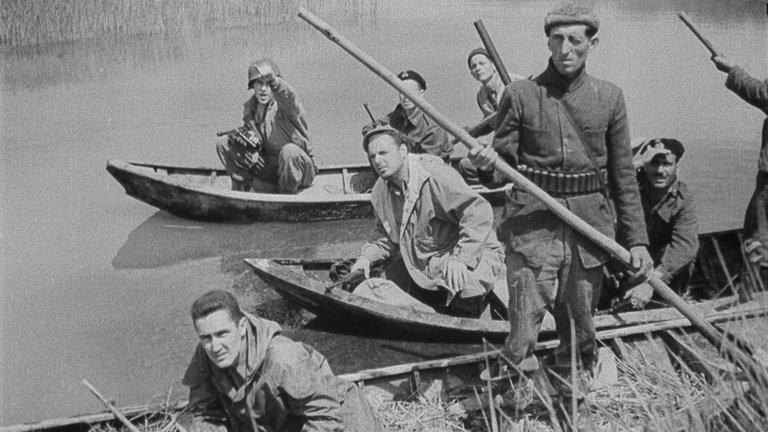Film Review: Paisan (Paisà, 1946)

Roberto Rossellini’s celebrated 1945 drama Rome, Open City is considered to be the rawest and the most authentic depiction of Second World War in Italy. That film, however, barely references Allies who took large role in those events. Rod E. Geiger, fim’s American producer and veteran of US Army Signal Corps, suggested Rossellini to address this issue in his next film. Rossellini listened to him and the result was 1946 war anthology drama Paisà, better known under its English title Paisan.
The title refers to “paisano”, Neapolitan word that, like generic Italian word “paesano”, literally means “countryman” , and which US military servicemen in Italy used for local population. The film is made of six stories, set in different sections of Italy and depicting different stages of Allied campaign in Italy. The first story is set in Sicily during initial Allied landing in in Sicily July 1943 and shows US Army patrol entering small village, with young soldier Joe (played by Robert Van Loon), despite not speaking language, bonding with a girl named Carmela (played by Carmela Sazio). Second episode is set in Autumn 1943, after Allies have taken strategic port city of Naples and black US military policeman Joe (played by Dots Johnson) tries to find street urchin Pasquale (played by Alfonsino Bovino) who stole his shoes. Third episode takes place in late 1944 in liberated Rome where Fred (played by Gar Moore), US Army tank driver on a leave, gets drunk and picks a prostitute name Francesca (played by Maria Minchi), unaware that she is the girl he had met and fell madly in love with months before while liberating the city. Fourth story takes place in August 1944 during the battle for Florence when US Army combat nurse Harriet (played by Harriet Meade) abandons her post and goes to still contested city where her pre-war lover is rumoured to lead Partisans. Fifth story takes place months later in a monastery close to German “Gothic Line” in Appenine Mountains which is visited by US Army chaplain Captain Bill Martin (played by William Tubbs) and two fellow chaplains who are, much to distress of the monks, revealed to be a Protestant and Jew. Sixth story takes place in December 1944 in marshes of Po Valley behind German lines where small number of American OSS and British SOE soldiers assist local partisans only to find themselves without ammunition, supplies and being brutally chased by numerically superior German forces.
Paisan is an anthology film, which is a form that was enthusiastically embraced by many Italian cinema in next few decades. In case of Rossellini’s film, it represents both its strength and weakness. Originally envisioned to feature seven instead six stories that show interactions between American servicemen and local Italians, Paisan suffers from lack of narrative coherence, with only connection between the segments being explanatory narration by Giulio Panicali, followed by documentary stock footage. Rossellini, on the other hand, maintains his trademark Neorealist style based on location shooting and non-professional actors, further enhanced by use of bombed out buildings, actors and extras who relive traumatic events from very near past. Like with many anthology films, quality of each segments varies a lot. Good thing about Paisan that many of such segments would appeal to different set of the audience. Arguably the best story is one set in Rome, which almost perfectly encapsulates harsh realities of war, mainly through transient nature of seemingly perfect relationships and horrific effects war-related poverty can have on peoples’ morals; Maria Michi, actress who portrays character in some way similar to the one she portrayed in Rome, Open City, delivers the best performance of the film. For fans of action, segment set in Florence provides very believable depiction of urban combat when situation is fluid, death is random and where freedom fighters summarily execute suspected German collaborators with little consideration. Segment most likely to be closest to Rossellini’s own heart is set in monastery, which the final speech of Captain Martin encapsulating director’s own Catholic humanism. The final segment is the darkest, featuring disturbing depictions of German atrocities, including heart-breaking scene when crying toddler is revealed as the only survivor in massacred village.
Paisan was, like so many Neorealist films, wasn’t too popular in its native country but it was, following its premiere at the first post-war Venice Film Festival, enthusiastically embraced by international critics. Rossellini would later make another film in the same style, set in post-war Germany and titled Germany, Year Zero, that would make the final piece of his “Neorealist Trilogy”. Today’s viewers might be impressed by Rossellini’s realism and uncompromising bleakness, but this approach have been embraced by other, often more successful, film makers making Paisan interesting mostly to viewers interested in cinema history or wanting to see authentic depiction of dark chapters of 20th Century history.
RATING: 6/10 (++)
_
Blog in Croatian https://draxblog.com
Blog in English https://draxreview.wordpress.com/
InLeo blog https://inleo.io/@drax.leo
InLeo: https://inleo.io/signup?referral=drax.leo
Stars Arena: https://www.starsarena.com/?ref=draxblog
Unstoppable Domains: https://unstoppabledomains.com/?ref=3fc23fc42c1b417
Hiveonboard: https://hiveonboard.com?ref=drax y
Bitcoin Lightning HIVE donations: https://v4v.app/v1/lnurlp/qrcode/drax
Rising Star game: https://www.risingstargame.com?referrer=drax
1Inch: https://1inch.exchange/#/r/0x83823d8CCB74F828148258BB4457642124b1328e
BTC donations: 1EWxiMiP6iiG9rger3NuUSd6HByaxQWafG
ETH donations: 0xB305F144323b99e6f8b1d66f5D7DE78B498C32A7
Posted using CineTV